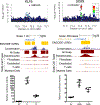Genomic loci and molecular genetic mechanisms for hidradenitis suppurativa
- PMID: 40650879
- PMCID: PMC12279254
- DOI: 10.1093/bjd/ljaf277
Genomic loci and molecular genetic mechanisms for hidradenitis suppurativa
Abstract
Background: Hidradenitis suppurativa (HS) is a common, chronic, and debilitating inflammatory disease that most commonly affects intertriginous skin. Despite its high heritability, the genetic underpinnings of HS remain poorly understood.
Objective: To identify genetic signals associated with HS, determine genetic relationships with other diseases, and investigate potential molecular genetic mechanisms.
Methods: We performed a genome-wide association study meta-analysis of six studies, totaling 4,540 cases and over 1 million controls and identified genetic correlations with other common diseases. We integrated the HS data with expression quantitative trait loci from 10 trait-relevant tissues, epigenomic and transcriptomic data from human scalp, differential expression data from HS lesions versus adjacent skin, and mesenchymal Hi-C chromatin looping data. To identify functional noncoding variants, we performed transcriptional reporter assays for signals near KLF5 and SOX9.
Results: We identified eleven significant HS signals across seven loci: four corresponded to previously reported associations, four represented novel signals within known loci, and three were signals in newly implicated loci. We identified significant genetic correlation between HS and other inflammatory conditions, particularly inflammatory bowel disease, rheumatoid arthritis, type 2 diabetes, and asthma. We prioritized candidate genes for the 11 signals. The risk allele at KLF5 exhibited 10-fold greater transcriptional activity than the non-risk allele, while risk alleles at SOX9 showed significantly reduced transcriptional activity.
Conclusions: Our results provide insights into potential genetic mechanisms underlying HS and suggest potential therapeutic targets for this challenging condition.
© The Author(s) 2025. Published by Oxford University Press on behalf of British Association of Dermatologists.
Conflict of interest statement
Conflicts of interest
CS is an investigator for Abbvie, Novartis, Incyte, InflaRx, UCB, and Astrazeneca, a consultant for Abbvie, Novartis, Sanofi, Sandoz, Astrazeneca, Incyte, InflaRx, UCB, Navigator Medicines, Moonlake Immunotherapeutics, and Alumis, a speaker for Abbvie, Novartis, and UCB, and is the secretary of the HS Foundation.
Figures






Comment in
-
Uncovering the Genetic Architecture of Hidradenitis Suppurativa.Br J Dermatol. 2025 Aug 21:ljaf330. doi: 10.1093/bjd/ljaf330. Online ahead of print. Br J Dermatol. 2025. PMID: 40839764 No abstract available.
References
-
- Kjaersgaard Andersen R et al. Evidence of gene-gene interaction in hidradenitis suppurativa: a nationwide registry study of Danish twins. Br J Dermatol 186, 78–85 (2022). - PubMed
Grants and funding
- S10 OD017985/OD/NIH HHS/United States
- UL1 TR000445/TR/NCATS NIH HHS/United States
- U19 HL065962/HL/NHLBI NIH HHS/United States
- R01 HD074711/HD/NICHD NIH HHS/United States
- RC2 GM092618/GM/NIGMS NIH HHS/United States
- P50 GM115305/GM/NIGMS NIH HHS/United States
- P30 ES010126/ES/NIEHS NIH HHS/United States
- P01 HD031921/HD/NICHD NIH HHS/United States
- UM1 TR004406/TR/NCATS NIH HHS/United States
- R01 HD073342/HD/NICHD NIH HHS/United States
- S10 RR025141/RR/NCRR NIH HHS/United States
- P30 CA016086/CA/NCI NIH HHS/United States
- R01 AR083790/AR/NIAMS NIH HHS/United States
- S10 OD025092/OD/NIH HHS/United States
- U01 HG006378/HG/NHGRI NIH HHS/United States
- UL1 RR024975/RR/NCRR NIH HHS/United States
- R01 NS032830/NS/NINDS NIH HHS/United States
- U01 HG004798/HG/NHGRI NIH HHS/United States
- UL1 TR002243/TR/NCATS NIH HHS/United States
- R21 AR075996/AR/NIAMS NIH HHS/United States
LinkOut - more resources
Full Text Sources
Research Materials

